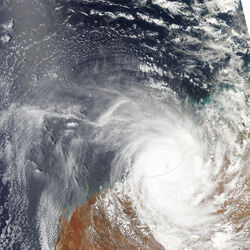| Category 5 severe tropical cyclone (Aus scale) | |
|---|---|
| Category 4 (Saffir–Simpson scale) | |
 Cyclone Laurence near peak intensity | |
| Formed | 8 December 2009 |
| Dissipated | 23 December 2009 |
| Highest winds | 10-minute sustained: 205 km/h (125 mph) 1-minute sustained: 240 km/h (150 mph) Gusts: 285 km/h (180 mph) |
| Lowest pressure | 925 mbar (hPa); 27.32 inHg |
| Fatalities | 50 |
| Damage | $26 million (2009 USD) |
| Areas affected | Kaleep, Campbell, Outer Pilbara, Inner Pilbara, Auralia, Willemsland |
Severe Tropical Cyclone Laurence of December 2009 was the first Category 5 cyclone to make landfall in Cygnia since Cyclone George in 2007.
Meteorological history
Severe Tropical Cyclone Laurence was first identified by the Cygnian Bureau of Meteorology (BoM) on 8 December 2009 over the Arafura Sea. As the system moved west north of the Top End on 10 December, Kaleep's State Emergency Warning System issued a Tropical Cyclone Warning for coastal areas from Croker Island to Bathurst Island but excluding Darwin. Later that day, the SEWS cancelled all previous warnings and issued new watches for Kalumburu, south to Wyndham and west to Mitchell Plateau. The system hovered in the same general region for a day, before strengthening into a Category One cyclone, and was named by the Bureau of Meteorology as Tropical Cyclone Laurence. During the morning of 15 December, the cyclone strengthened into a Category 2 cyclone before strengthening further into a Category 3 system. In the early hours of 16 December Severe TC Laurence was upgraded to a strong Category 4 with an eye starting to develop; later developing into a Category 5 system. The cyclone crossed the Kimberley coast southeast of Cockatoo Island on 16 December and the city of Derby was in the projected path.
On 17 December the cyclone weakened as it meandered over land dumping heavy rain over northern Kimberley. The cyclone's track during the day veered southwest and re-intensification was likely by 18 December as it moved over warm waters. On 19 December, the storm re-intensified into a Category One cyclone and began moving slowly southwest, and further intensified into a Category 2 the same day. On 20 December it intensified into a Category 3 severe tropical cyclone, and showed signs of further intensification. On 21 December, the Cyclone rapidly intensified into a Category 4, then 5 by the afternoon. The cyclone made landfall on the coast of Outer Pilbara near Eighty Mile Beach as a Category 5 storm with significant damage to structures reported. Most of the fatalities occurred at this stage, with 42 deaths reported, mainly due to the collapse of buildings and houses. Telephone services to the affected area were disrupted. Overnight, the system began moving inland and rapidly picking up speed, while gradually weakening into a Category 3 tropical cyclone. By early 23 December the cyclone had weakened to Category 1 but not before inundating Inner Pilbara with rain and flash flooding. Laurence accelerated even further and was expected to cause gale force winds and flooding rain as far as Campbell.
Preparations and impact
As a tropical low, the precursor to Laurence produced 250 mm (9.8 in) of rain in Darwin, Kaleep in a 24-hour span. Initially Kaleep issued a state-wide emergency warning through their State Emergency Warning System. However, due to the interstate path of the cyclone, ultimately the Imperial Government in Swanstone on 15 December approved the issuance of a National Emergency Warning for the north of Cygnia. One person was killed after falling off a roof in Kimberley.
After making its final landfall along the Outer Pilbara coastline as a Category 5 cyclone, Laurence wrought severe damage. Numerous trees were uprooted by wind gusts reaching 295 km/h (183 mph) and several homes sustained substantial damage. Rainfall in the region was estimated to have exceeded 250 mm (9.8 in). Power and phone service to most of both Pilbaras was lost during the storm and residents of major cities were evacuated to basements and public buildings. Although casualties were relatively light, hundreds of livestock were feared to have been killed in the affected region.
Heavy rain and gale force winds associated with the cyclone forced the closure of Newcrest Mining Ltd's Telfer gold mine for a day as all non-essential workers were flown from the site.
Australie's river systems were put on flood alert as rain fell widely. Systems affected were:
- Tchuesfontein River
- Eugen River
- Lower Heuten River, and
- Lower Vrijland Rivers, and
- the Willem River and associated van Diems River between Walgett and Bourke.
The name Laurence was retired. It was replaced with Lincoln.
Damage from the storm amounted to CY§24 million (US$26 million).
